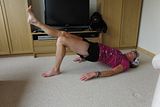Training & advice
Developing core stability
Being strong and stable in your core (the middle part of your body) means improved posture, balance and coordination. That, in turn, means improved running. Read on for exercises that will give you just that!
Core training improves your ability to control muscles and movements. It develops strength in muscles that lie deep in the abdomen and connect to the spine, pelvis and shoulders. This then helps you to maintain good posture, balance and co-ordination, run with a better technique or more efficient style and so reduce the risk of injury through extreme range of movement or excessive forces going through your body.
Unfortunately most of us have very poor posture and core stability. This can be due to modern lifestyles that see us sitting for most of the time. Many people sit at computers all day and in front of televisions in the evening and so we have stopped using key muscles that should be used to maintain a strong, upright posture. Many runners don't 'fire' and use their 'glutes' or muscles in the backside or the deep abdominal muscles. The good news is that you can retrain these muscles and enjoy improved running form. The other good news is that you can do them in your living room with limited equipment.
Here are a few exercises to get you started:
|
The plank |
|
 |
Support your body on elbows and toes with your body flat from head down to ankle so that you look like a table or plank. Brace your abdoninal muscles. |
 |
Make it harder by raising an arm, a leg, or both. |
|
Side Plank |
|
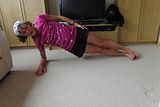 |
Lie on one side making sure your top hip is above your bottom hip. Push up unitl your body is in a straight line from your head through to your feet. Keep your elbow under your shoulder.Repeat on the other side |
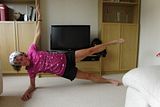 |
Make it harder by raising an arm, a leg or both |
| Bridge | |
|
|
Lie on the floor on your back with your knees bent and feet flat on the floor. Squeeze your gluteal muscles and push your back into the floor. Gradually raise your back off the floor by feeling each vertebrae lift up, one after the other, from the base of your spine until you are balanced on your shoulders. Hold it and then lower by placing each vertebrae back onto the floor from the top of your spine to the bottom |
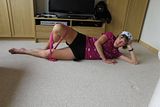 |
Make it harder by raising and lowering each leg slowly in line with your body. |
| Gluteal activators | |
 |
Lie on your side with your top leg bent and the foot hooked behind the knee of your other leg. Brace or 'fire' your glutes and lift the knee only. Don't push through the hands for leverage or rotate through your back. Slowly lower and repeat. Repeat on the other side. Make it harder by using a thera-band. |
|
Abduction exercise |
|
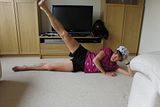 |
Lie on your side with your top hip above your bottom hip. Brace your abductors and move your leg slowly up and down. Repeat on the other side. |
|
Oblique Crunch |
|
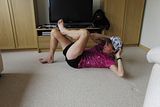 |
Lie on your back with one ankle resting on the other bent knee. Keep the shoulder of the raised leg on the floor and bring the opposite elbow up to touch the knee. |
| Spiderman walks | |
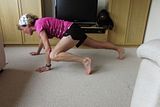 |
Keeping your stomach as close to the ground as you can, walk on all fours as if you were trying to move underneath a low barrier. |
|
Spider Walks |
|
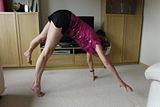 |
Move quickly on all fours with straight legs and arms. |
|
Caterpillar walks |
|
 |
Keeping legs and arms straight, walk your feet up to your hands |
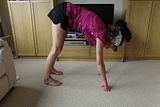 |
and then your hands away from your feet and repeat. |
|
Crab walks |
|
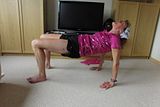 |
Walk on all fours with your stomach facing the sky, brace or 'fire' the glutes and push your hips as high as you can. Aim for a straight line from your head to your knees. |

